“My department is being treated unfairly by the press. How can I become more media savvy?”
For many fire and EMS leaders, the relationship with journalists remains difficult, even hostile. (And make no mistake: There are legitimate complaints on both sides.) If you find yourself facing an “us versus them” dynamic, you need to both build personal relationships with individual journalists and develop a proactive strategy that anticipates the stories that will be making the news.
Your goal is to use this powerful ally to get your message out. But working successfully with the media takes time, practice and a willingness to understand how reporters work and what they need from you. Here are some helpful tips:
1. Understand where they’re coming from.
A reporter’s job is to serve readers, TV viewers, radio listeners and Internet users with accurate, interesting and timely reports (unfortunately, not always in that order). Their goal (usually) isn’t to make you look good or bad, just interesting.
2. Create relationships.
Talk to journalists and understand the constraints under which they operate. These include tight deadlines, the need for simplicity and speed, the influence of editors on the final story (and headline) and the editor’s role in deciding whether the story even runs or not.
3. Understand what’s news — and what isn’t.
When is something newsworthy? What is the angle or news hook that a reporter and editor will be interested in? Typically, if it’s first, oldest, biggest, or smallest — or something seasonal that stands out and is relevant today — it’s news. If an issue is already in the national news, it’s a good time to seize the opportunity and immediately contact the media with your local spin. If you simply want to tell people how wonderful your agency is, try to connect your positive message to something timely, like a report, a new station, or new statistics.
4. Get to the point.
Today more than ever, journalists are pressed for time. Whether you’re being interviewed or writing a press release, get right to the point. The reporter should be able to tell what you’re talking about right off the bat. The reporter’s audience will probably have an even shorter attention span. Learn to use short, punchy statements (and stay clear of jargon, acronyms and radio codes that the public won’t understand).
5. Don’t forget your area of expertise.
Television news producers in particular like to position their programs as “protecting” their audiences from all sorts of threats — think severe weather, killer bees, crooked car-repair shops … you name it.
As emergency responders, your personnel can offer truly helpful advice on avoiding heat or cold emergencies, fire safety, child car-seat safety, preventing elder falls, how to call 911 and many other topics. This is a terrific opportunity to portray your organization in a positive light and develop a strong working relationship with the media. Do it.
6. Prepare for crisis communications.
When EMS is a hard story or you have crisis communications, it usually involves a situation that unfolds without notice. Develop a crisis communication plan ahead of time, with a designated spokesperson. Pre-plan multiple common scenarios (e.g., EMS involved in a fatality crash, criminal charges against a staff member, etc.).
Know and practice your key positive message points for each potential scenario. Develop key messages and practice questions and short answers that bridge to your positive points. Be as proactive as possible, to show that your agency is doing something about the situation, even if you’re unable to share details at the moment.
7. Avoid common pitfalls.
If a reporter asks you a “negative” question (such as “What do you say to the accusation that XYZ EMS routinely overbills its patients?”) you may be tempted to use some of what the reporter said in your reply, to emphasize your point of view epeating the negative question (for example, “XYZ EMS absolutely, positively does not overbill its patients”). Guess what ends up as a sound bite on the news that evening?
Reporters often ask negative questions to get dramatic quotes. Instead, answer the question directly but positively, avoiding the reporter’s negative phrasing. (“No. XYZ EMS has an exemplary billing record, and we have dedicated customer service personnel who help our patients every step of the way through the billing process, even if they’re having trouble with their insurance company.”)
8. Other things to avoid.
Media savvy leaders also avoid letting their impatience show; blaming; using humor, jargon or non-understandable statistics; and thinking that they can be off the record with a reporter. Never lie to, agree with or embarrass a reporter. Most of all, don’t take it personally.
9. Use Social Media.
For EMS, a clear goal with social media is to build a community of interested persons. It could involve working with a variety of local neighborhood groups or healthcare professionals about prevention or another area of common interest. Social media can take on many different forms. These include forums, blogs, podcasts, videos and wall postings, among others. Social media tools such as Twitter, Facebook and LinkedIn are allowing EMS agencies to communicate with a variety of audiences.
Any media strategy requires an initial and ongoing investment to make sure your message reaches the intended audience and is deemed timely and relevant. If you think seriously about adopting these simple guidelines, you’re already ahead when it comes to being more media savvy.













